Note: This preview uses pre-release components and rules. What you see here may be different from the final, published game.
 I always have my eye out for unique skirmish games to try out. Over the past year alone I’ve dipped my toes into Cyberpunk Red: Combat Zone, Gaslands (review coming soon), Star Wars Shatterpoint, and Flickfleet (off the top of my head). But an upcoming one I’ve been really interested in is Malediction.
I always have my eye out for unique skirmish games to try out. Over the past year alone I’ve dipped my toes into Cyberpunk Red: Combat Zone, Gaslands (review coming soon), Star Wars Shatterpoint, and Flickfleet (off the top of my head). But an upcoming one I’ve been really interested in is Malediction.
This one is published by Loot Studios. I wouldn’t be surprised if you haven’t heard of them because they are not a board game publisher, at least not yet. Loot Studios has made a name for itself by providing high-quality STL files for people with 3D printers. If you want minis, terrain, and other cool stuff to print yourself, they are one of the best sources.
Now, they have entered the board game arena with their launch of Malediction on Gamefound. We’ve had a chance to try this one out and are ready to let you know what we think.
Gameplay Overview:
Malediction feels like a combination of a Warhammer-style skirmish game and Magic: The Gathering. You can build your own custom deck or use one of the premade starter decks. We grabbed a couple of the starter decks for our first few games to keep things simple.
Malediction is played over a series of rounds, with each round having 4 phases:
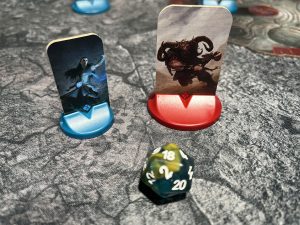
1. Refresh phase: Players refresh exhausted units, draw 2 cards from their deck, and gain Echo equal to 2x the current round number—Echo is the game’s currency. The round counter caps out at 5, so after that round, players will only gain 10 Echo per round.
2. Deploy phase: Players can deploy units into the battlefield by spending Echo. Most will start in your deploy zone near your side of the board. But starting in round 2, you can deploy a unit as a reinforcement, which lets you deploy it near any unengaged unit on the battlefield. This will help you rapidly get units into the action.
3. Action phase: Players alternate activating one of their unexhausted units. Units have 2 AP to use to move (equal to their move value) or attack. Each of those actions costs 1AP. Attacking is handled by rolling a d20 and adding your unit’s attack value. If it equals or exceeds your opponent’s defense value, you do full damage. If it doesn’t, you hit with a glancing blow and the defender suffers a lower amount of damage. Attacks can be melee or ranged, and critical hits will let you do extra damage.
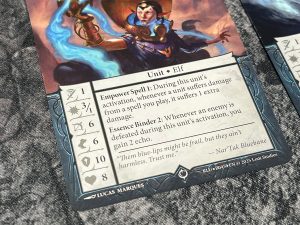
Players can also play spells from their hands during a turn to help give them an edge in the battle. These will do things like refresh exhausted units, deal extra damage, or prevent damage.
4. End Phase: One of the goals in Malediction is to gain relics. These are placed around the board, and if you end the round controlling one, you can claim a relic and add it to the hero. These are powerful items that will give you a sizable boost in combat. It also grants you Mastery points. You earn Mastery for controlling relics and killing your opponent’s units. The first to 25 mastery (for the intro game) is the winner.
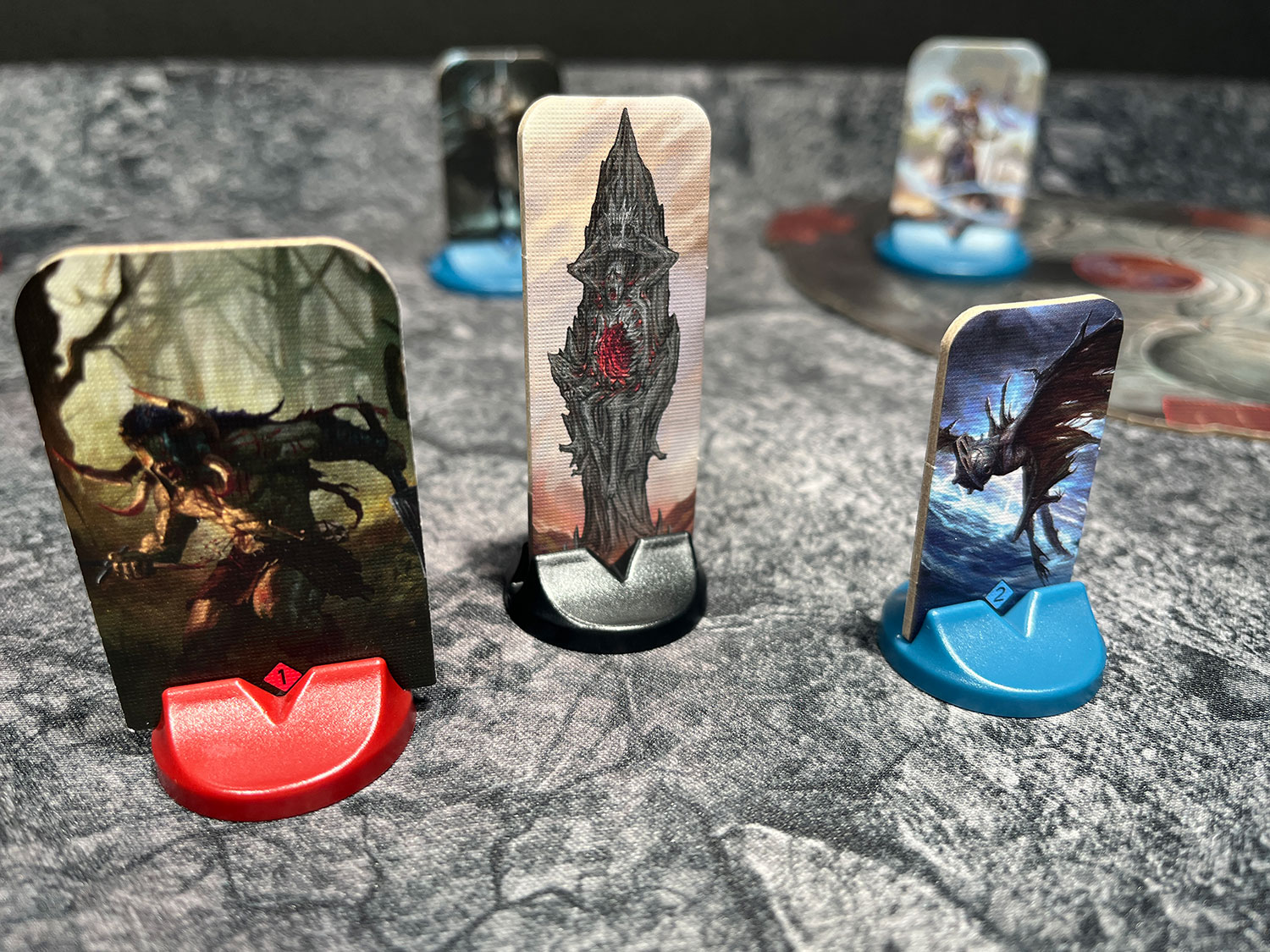
Gameplay Impressions:
Despite being a first-time board game publisher. I was pretty impressed with Malediction. The gameplay is snappy and smooth, with most of our games taking under an hour. One of the reasons is that it’s not just a brawl, but a race for victory points. Turtling up isn’t going to get you relics, each of which has the ability to turn the tide of battle.
You also gain points for the cost of enemies you defeat, so it pays to spend time taking out those really strong units. Add to this the fact that you can reinforce units to the heart of the action, and you won’t have to waste turns plodding a new unit into the battle. As long as you have 1 unengaged unit out there, it can act as a spawn point for new units.
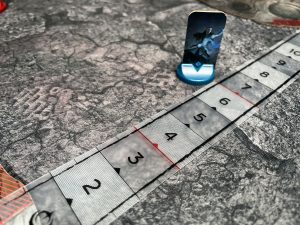
While Malediction is a new world, it’s got some serious gaming power behind its lore. The world for Malediction was written by Tracy Hickman (of Dragonlance fame). And while the preview copy didn’t have the generous lore of a Games Workshop book, the four factions all felt really unique.
There is the Legion of the Fallen, a faction of undead who can swarm the battlefield with their cheap minions. Or the Primal Blood faction, who are all about strong attacks, sometimes at the sacrifice of their own health. The Order of the Shattered Throne is defensive-minded with lots of healing preventative spells, while the Conclave of the Spheres is all about magic and trickery. You can almost see some Magic: The Gathering color influence here with Primal Blood being red, Shattered throw White, etc…
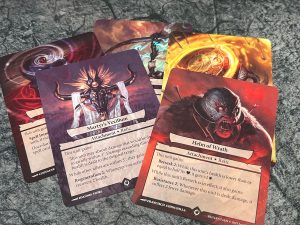
The most unique thing about Malediction though is how it’s being offered. The core boxes come with rules, cards, and standees. It’s everything you need to play a game, minus the bling. There is no battle map, acrylic tokens, or minis. It’s that last one where things get interesting. As Loot Studios is an expert and providing 3D printable files for miniatures, they are doing exactly that with Malediction.
When you buy a box, you get a QR code to download minis for your faction to print yourself. And if you don’t have a 3D printer, they have a list of vendors you can reach out to do for yourself. This is an interesting approach as I’ve heard time and time again from people who don’t want to pay for the plastic and are happy with using standees. It will be interesting to see if the audience gravitates towards this model.
Final Thoughts:
I enjoyed my plays of Malediction. The rules are snappy, the gameplay smooth, and the factions interesting. The combination of cardplay with the tactical nature of the skirmish game was a nice mashup where each side feels like it’s equally important. Many times when games do this it feels like one side is just there in spirit, while the real game is with the other. It feels like Malediction got this balance right. I’ve only scratched the surface of what Malediction has to offer, but so far, I like what I’ve seen. If the thought of combining Magic: The Gathering with a skirmish game is appealing to you, check out their just launched campaign on Gamefound, now in funding.
Source: Board Game Quest





